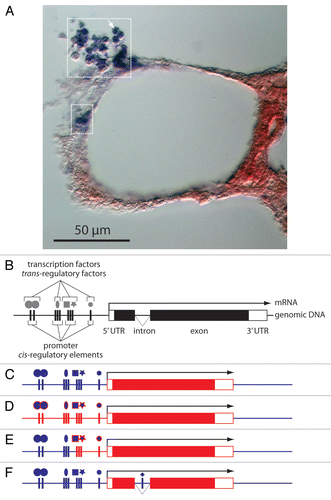Figures & data
Figure 1 HGTs of transcribed DNA need to be delivered with, or recruit appropriate regulatory elements. (A) The horizontally transferred gene Awi-Spherulin is exclusively and highly expressed in a subset of A. willeyana's cells, those that secrete calcified spherulites.Citation1 A histological section of A. willeyana reveals Awi-Spherulin positive cells (within dashed boxes—an individual cell is indicated by the arrow) following in situ hybridization against the transcribed Awi-Spherulin mRNA. Other sponge cells (stained red) are devoid of Spherulin transcripts. The spatial and temporal specificity of Awi-Spherulin expression is governed by the cis- and trans-regulatory elements associated with the Awi-Spherulin gene. (B) A schematic representation of a eukaryotic gene and the associated trans-regulatory elements (transcription factors). (C–F) One, or a combination of several possible scenarios regarding the regulation of Awi-Spherulin expression must have occurred following the HGT that established Spherulin in the A. willeyana genome. Red elements represent horizontally transferred exogenous DNA, blue elements indicate A. willeyana endogenous molecules. The most simplistic scenarios are: (C) Spherulin was integrated into a genomic locus that already possessed the cis- and trans-regulatory elements necessary to drive the expression of Awi-Spherulin within spherulite forming cells. For example the Astrosclerin geneCitation26 may have had these regulatory elements in place at the time of the Spherulin HGT. These elements could have been co-opted to immediately drive the expression of Awi-Spherulin within spherulite forming cells; (D) The HGT delivered the Spherulin open reading frame together with ‘xeno’ cis-regulatory elements (red vertical bars). These foreign cis-regulatory elements were then able to recruit A. willeyana transcription factors to drive the expression of Awi-Spherulin in spherulite forming cells. Such a scenario may have been expedited by recruiting evolutionary conserved homologs of the transcription factors used to regulate the ‘original’ expression of the bacterial homolog of Spherulin. These conserved, but A. willeyana specific, transcription factors are indicated as blue shapes with a red outline. Such a scenario would presumably require the action of selective forces to refine the expression of Spherulin in spherulite forming cells. (E) a combination of the above two scenarios may have occurred, with subsequent selective pressures refining the expression of Awi-Spherulin; (F) The Awi-Spherulin gene possesses a spliceosomal intron.Citation1 Introns can contain regulatory elementsCitation35 supporting the likelihood that the expression of Awi-Spherulin was modified and refined after its integration into the A. willeyana genome (as opposed to scenario C) through the addition of eukaryotic genetic features.
